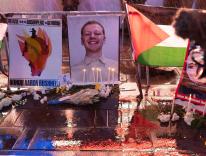While preparing a lesson about libel for my journalism students, I recently leafed through articles I had written on Gen. William C. Westmoreland’s libel suit against CBS News in 1984. CBS had accused the general of deliberately underestimating the enemy’s troop strength during the Vietnam war, thus giving a false impression that the war was winnable. Westmoreland, charging that his honor had been impugned by slanted reportage, file a defamation suit.
My recollection is that both sides fared poorly in the courtroom battle. The evidence demonstrated some shoddy journalism on CBS’s part, with outtakes showing that interviews were quoted very selectively. But the testimony from Westmoreland’s chief of intelligence also showed that he had delayed reporting a higher enemy troop strength to Washington out of fear it would be a “political bombshell.” Rather than submit the case to the jury, Westmoreland settled the suit without collecting any damages. One press room colleague said, that CBS "framed him for something he did."
Seymour Hersh’s article in the March 30 New Yorker, “The Scene of the Crime: a reporter’s journey to My Lai and the secrets of the past,” revisits the question of how important truths about the war were covered up. It’s a chilling piece in which Hersh recounts how he reported on the massacre at My Lai on March 16, 1968, when U.S. troops rounded up and executed women, children and elderly people. Returning to the scene of the crime, he visited a Vietnamese museum dedicated to the massacre and reports:
The museum’s count, no longer in dispute, is five hundred and four victims, from two hundred and forty-seven families. Twenty-four families were obliterated—–three generations murdered, with no survivors. Among the dead were a hundred and eighty-two women, seventeen of them pregnant. A hundred and seventy-three children were executed, including fifty-six infants. Sixty older men died.
Hersh reports that U.S. military authorities were well aware that such massacres of civilians were occurring in central Vietnam—and that My Lai was no isolated incident. He cites an internal report the Pentagon completed the year before the My Lai massacre. W. Donald Stewart, chief of the investigations division in the Defense Department’s Directorate of Inspection Services, interviewed hundreds of people, reaching the conclusion that many soldiers he interviewed “felt they were at liberty to substitute their own judgment for the clear provisions of the [Geneva] Conventions. . . . It was primarily the young and inexperienced troops who stated they would maltreat or kill prisoners, despite having just received instructions” concerning the Geneva Conventions.
The report was sent to Defense Secretary Robert McNamara. Hersh reports that McNamara had another source of information about My Lai-type massacres. The writer Jonathan Schell had returned from a 1967 reporting tour in Vietnam so disturbed at what he learned that he agreed to allow a well-connected family friend arrange for him to brief McNamara (an action journalists would normally be reluctant to do, but which Schell felt was morally necessary in this case). Hersh reports:
McNamara had sent Schell’s notes to Ellsworth Bunker, the American Ambassador in Saigon. Apparently unknown to McNamara, the goal in Saigon was not to investigate Schell’s allegations but to discredit his reporting and do everything possible to prevent publication of the material.
After My Lai, Schell wanted to disclose that he had reported other atrocities directly to McNamara, but McNamara insisted he honor the agreement that their discussion was off the record. Schell honored the agreement. With both McNamara and Schell deceased, Hersh has disclosed yet another secret of the war—further evidence of how the leaders of the war effort tried to cover up the truth.
Please email comments to [email protected] and join the conversation on our Facebook page.
Previous Story
Selling the Bible in Cinéma Vérité
Next Story
A Broadened Heart

